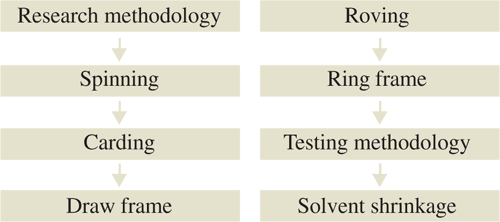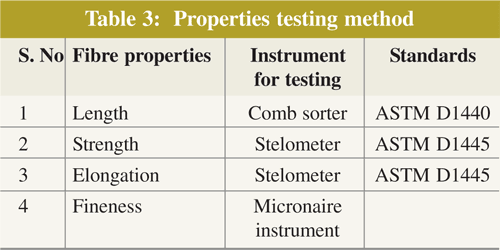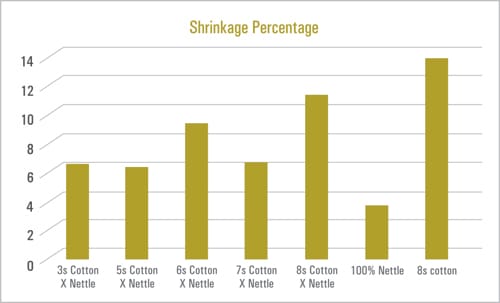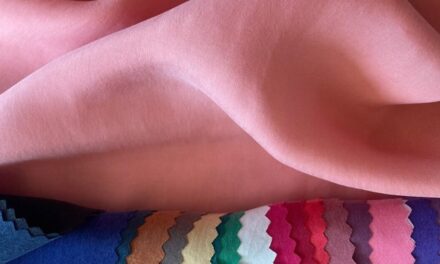
The Himalayan Nettle (Girardinia diversifolia) has been used for centuries as fibre and food source by Himalayan communities. Himalayan Nettle is a natural cellulosic fibre that can be handled in the same way as other cellulosic fibres. The fibre has natural functional characteristics of shrink resistance, degree of pathogen and fire resistance and can blend nicely with other fibres. Most importantly it can be disposed of using all ends of life opportunities. The fabrics may potentially be reused or re-manufactured and can also be used as a source of cellulose feedstock for regenerated cellulosic products. Being naturally bio- degradable, the fibre can be composted if required.

Cotton fibre is amazingly versatile, whether alone or blended, it outsells all other fibres combined. Cotton is popular because it’s easy to care for and comfortable year-round. It does wrinkle easily and is prone to shrinkage; however, blending cotton with other fibres and permanent fabric finishes reduces wrinkles and shrinkage. Functional finishes, such as durable press and mildew- , flame- and stain-resistance, have added to cotton’s appeal. Even with shrinkage control, most cotton fabrics shrink during the first wash, so it’s imperative to prewash them before sewing.
Blending with synthetic fibres or using chemical functional finished in cotton is today considered unsustainabl practise. Few unusual fibres growing naturally are having in-built functional properties and are gaining popularity as these are considered sustainable to environment and human beings. Himalayan Nettle is one such natural fibre growing wild in Uttarakhand forests.

Materials and methods
The Cotton and Nettle mix yarn were spun in open end spinning mill in yarn count 3s, 5s, 6s, 7s and 8s. 100 per cent Nettle is hand spun yarn made on Bageshwari charkaha, especially used for spinning Nettle fibres in remote village clusters of Uttarakhand. Table 1 shows properties of Cotton Nettle mix, Cotton and Nettle yarn spun.
Methods
The method consists of research methodology and testing. The process consists of spinning the blends and hand spinning pure nettle.
The following flowchart shows the steps involved in reaching to research and test methodology.

The Himalayan nettle and Cotton fibre, which was used for this work, were studied using standard testing method using appropriate testing instrument as shown in Table-3.
The Himalayan Nettle and Cotton yarn, which are used for this work, the properties were studied using standard testing method using appropriate testing instrument as shown in table 4.
The Nettle and Cotton yarn shrinkage testing properties were studied using standard testing method using appropriate testing instrument as shown in table 5.
Result and discussion

Five varieties of mill spun yarn in different counts were developed and one hand spun 100 per cent Nettle yarn was developed and their properties of shrinkage in solvent (Mercerisation) were studied. The quality analysis is given below.
Yarn shrinkage test

Shrinkage is a process where size of textile material (yarn or fabric) is reduced to its original size. Cotton fabrics are prone to high shrinkage during washing and mercerising. Whereas, Nettle exhibit better resistance to shrinkage.
As per ASTM method D2259, the extent of change in the length of yarn is dependent upon the fibre type and upon the time and temperature of the exposure. Fibre types differ in their reaction to elevated temperature as well as the nature of the specific solvent, and prior fibre history can have a great influence upon the heat and solvent shrinkage of a yarn. This test method is used to determine the shrinkage of yarns in skein form when treated in boiling water, dry heat, saturated steam, or solvents. This test method is applicable to yarns made from any fibre or combination of fibres where the tex of the yarn is known or can be determined. Figure 1 shows the result of shrinkage test of yarns developed.
The shrinkage data was statistically analysed. Three individual reading of one yarn is taken thereafter average shrink percentage of each yarn was analysed. A comparative analysis of all the yarns was studied. It is clearly indicated that the values were significantly different.
Conclusion

The five varieties of yarns are blended with cotton in 60:40 ratio and different counts yarns are mill developed. 100 per cent Nettle is hand spun. All the six varieties of yarns along with cotton 8s were tested with shrinkage test and results were critically analysed. It was observed that 100 per cent Nettle has least shrinkage of 3.36 per cent while pure cotton has shrinkage approx. 13.6 per cent. Cotton exhibits four times more shrinkage than 100 per cent Nettle. It also shows that Cotton Nettle blend exhibits low shrinkage than cotton. Therefore, more is the ratio of nettle in the yarn less will be the shrinkage. Pure Nettle fabrics developed with improved processing will be suitable for clothing and will not have shrinkage issues





















